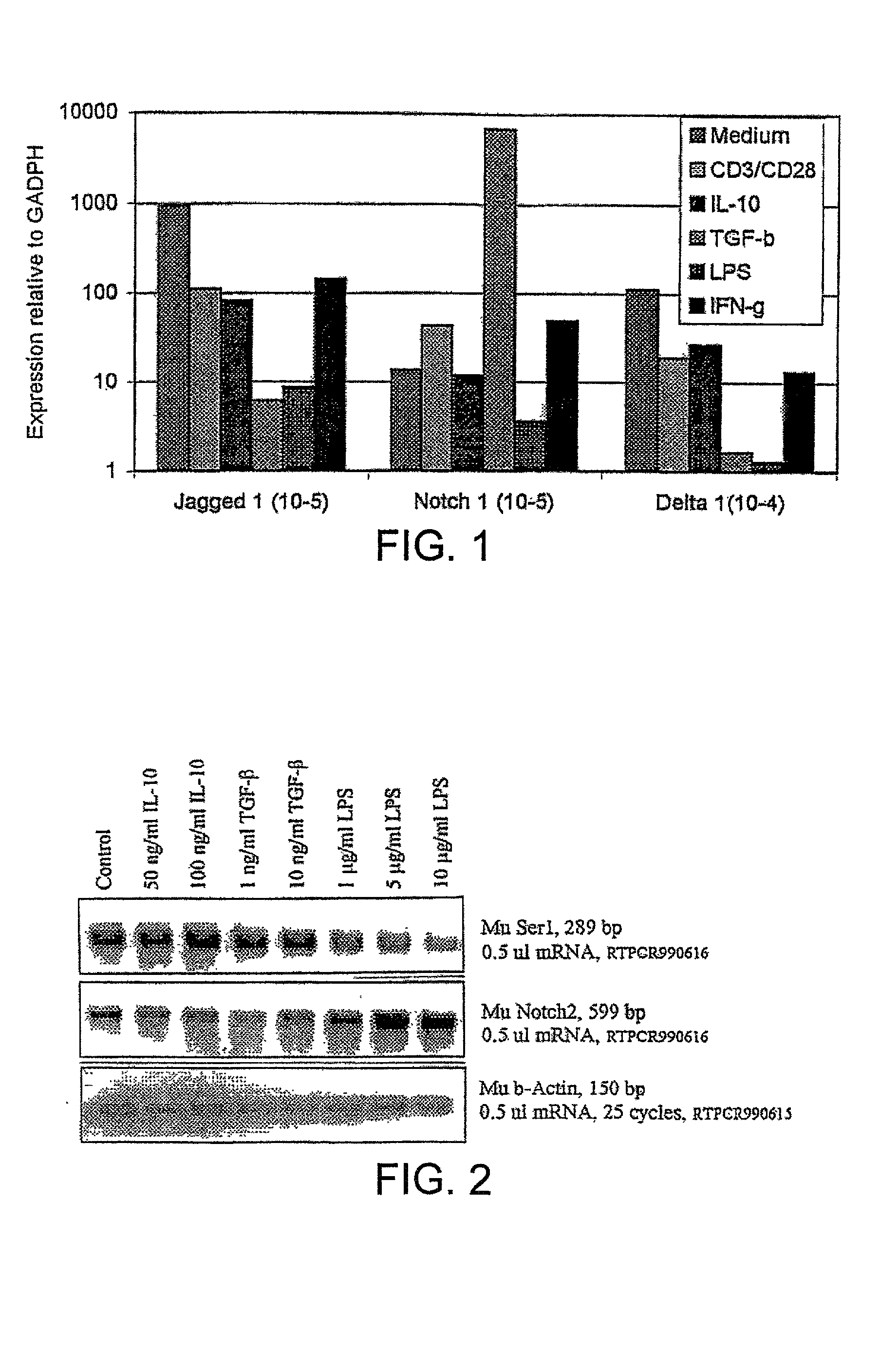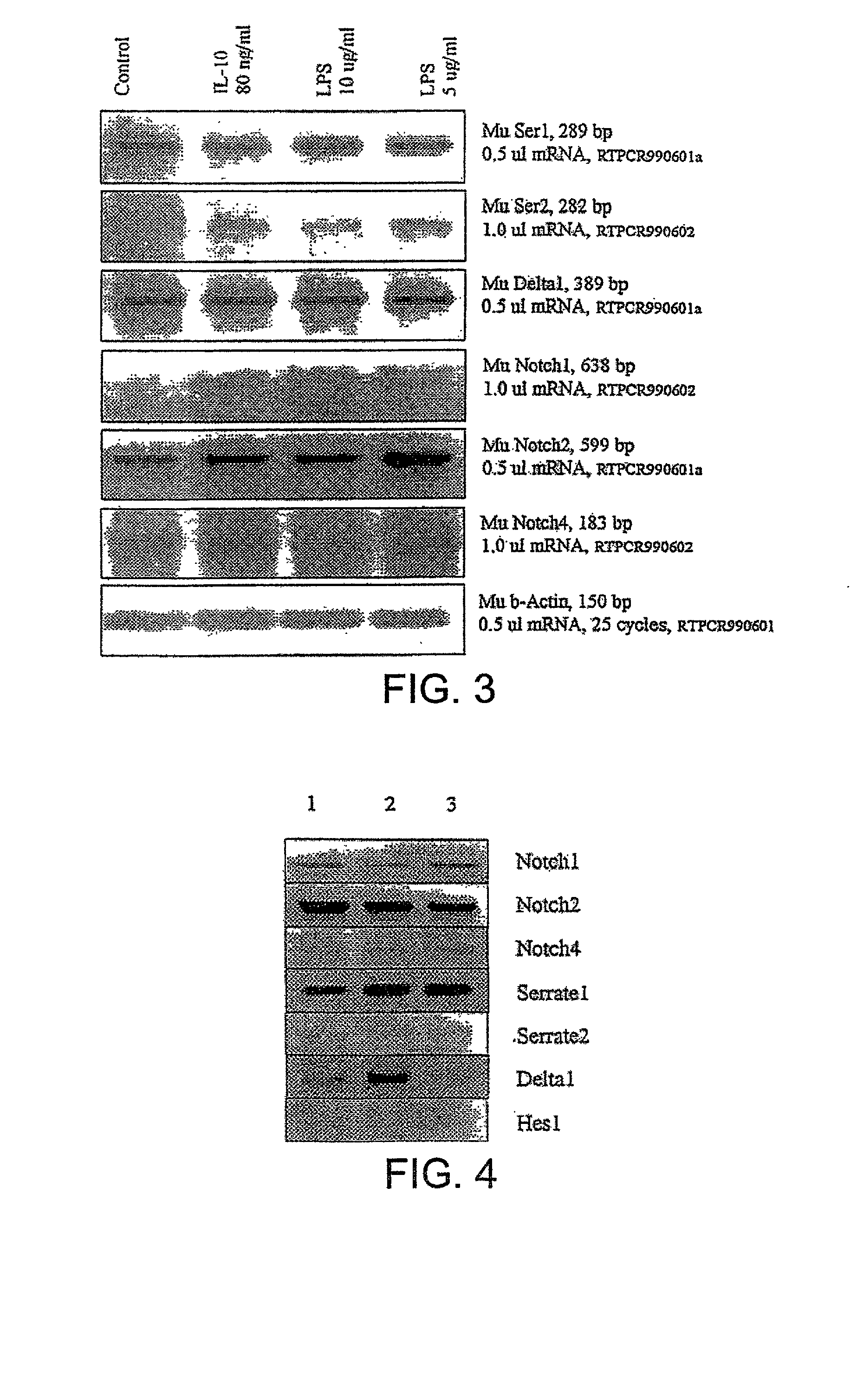Methods of immunosuppression
a technology of immunosuppression and immunoglobulin, applied in the field of immunosuppression, can solve problems such as failure to properly regulate toleran
- Summary
- Abstract
- Description
- Claims
- Application Information
AI Technical Summary
Benefits of technology
Problems solved by technology
Method used
Image
Examples
example 1
[0151] Assays to Determine to Identify Substances that Upregulate Notch Ligand Expression.
[0152] Dendritic cells (DCs) are the primary antigen presenting cell in the immune system and are critical for stimulating T cell responses. DCs are obtained from the spleen of mice and transferred to flasks containing tissue culture medium (RPMI 1640 with 10% fetal calf serum added). Cytokines (eg IL-4 and GM-CSF) are added as appropriate.
[0153] Cells are then transferred into 12-well tissue culture trays. To each well is added a different candidate upregulator of Notch ligand expression. Delta and Serrate expression is monitored at various time points by removing an aliquot of cells and determining induction of Delta and Serrate expression by PCR.
[0154] Similar procedures are also carried out using a T cell hybridoma cell line and T cells obtained from mice as described in the materials and methods section.
example 2
[0155] Preparation of Primed Dendritic Cells
[0156] DCs are obtained from the spleen of mice as in Example 1 and divided into two cultures. The first culture is transfected with a retrovirus allowing expression of the fill length Serrate-1 protein to serve as a positive control. The first culture is then pulsed with the HDM peptide p110-131 for 3 hours at 37.degree. C. The second culture is split up into several tissue culture plate wells and to each well is added a different upregulator of Notch ligand expression identified in Example 1. These wells are then also pulsed with the HDM peptide p110-131 for 3 hours at 37.degree. C.
[0157] The DCs are then washed and used to immunise naive mice subcutaneously using 10.sup.5 cells / mouse. After 7 days the draining LNCs are recovered and restimulated in culture with peptide at 4.times.10.sup.5 cells / well. Since the mice were only immunised with peptide-pulsed DCs this gives us a measure of the ability of these cells to prime an immune respon...
example 3
[0158] Upregulation of Serrate expression in antigen presenting cells prevents T cell responses.
[0159] An influenza-reactive human T cell clone HA1.7 is mixed with peptide HA306-318 (1.0 .mu.g / ml) in the presence of L cells expressing HLA-DRB1*0101(as antigen presenting cells), using 2.times.10.sup.4 of each cell type. The L cells have been preincubated with one or more substances identified as being capable of upregulating Serrate expression in APCs for 6 hours. The proliferative response is measured after 72 hours following addition of tritiated thymidine for the last 8 hours of culture.
PUM
| Property | Measurement | Unit |
|---|---|---|
| Composition | aaaaa | aaaaa |
| Molecular weight | aaaaa | aaaaa |
| Immunogenicity | aaaaa | aaaaa |
Abstract
Description
Claims
Application Information
 Login to View More
Login to View More - R&D
- Intellectual Property
- Life Sciences
- Materials
- Tech Scout
- Unparalleled Data Quality
- Higher Quality Content
- 60% Fewer Hallucinations
Browse by: Latest US Patents, China's latest patents, Technical Efficacy Thesaurus, Application Domain, Technology Topic, Popular Technical Reports.
© 2025 PatSnap. All rights reserved.Legal|Privacy policy|Modern Slavery Act Transparency Statement|Sitemap|About US| Contact US: help@patsnap.com


